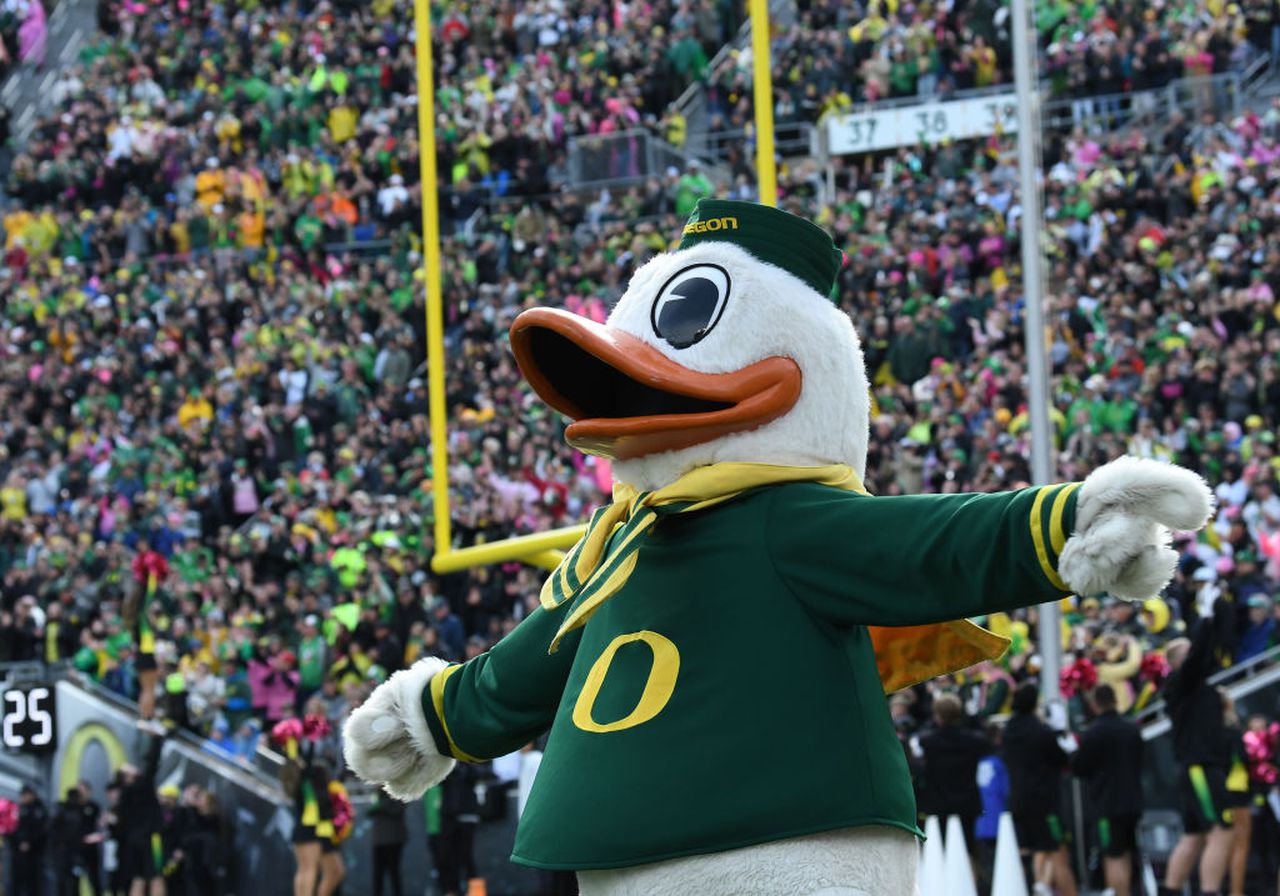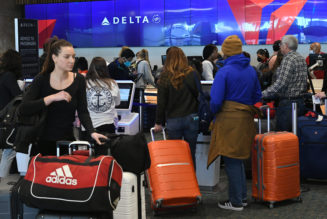
The Oregon Ducks will face better competition and become far more accessible for fans to watch when they move to the Big Ten next year. That in turn will lead to more money via the conference’s media rights distribution compared to what UO has received and could’ve received had it stayed in the Pac-12.
But joining the more prestigious and successful league based overwhelmingly in the Midwest also comes with logistical burdens that will be felt across Oregon’s 20 sports teams.
The issues presented by more frequent cross-country travel were probed at length while UCLA went through its process of approval to change conferences by the University of California’s board of regents last year.
Asked whether Oregon has made commitments for charter flights when its teams have to fly as far as New Jersey, Maryland and central Pennsylvania, UO athletic director Rob Mullens said those details are still being sorted out.
“The student-athlete experience is our highest priority and obviously travel is a piece of that,” Mullens said. “We don’t have those details down to the fine point on charters at this point. Obviously we know there’s going to be some added travel costs and we will solve for that. In our conversations with the leadership at the Big Ten they understand the importance of scheduling and I was very impressed with how thoughtful they are to this and the impact. I’m confident we’ll find a good solution to make sure we find the right balance for our student-athletes.”
In football, Oregon will still play a nine-game conference schedule in 2024 and most likely in 2025 as well, based on the Big Ten’s previously announced matchups in its Flex Protect Plus model, which protected 11 of the league’s historic and geographic rivalries and trophy games. Teams were to play every conference opponent at least twice, once home and away, over a four-year period.
That model will be modified with the additions of Oregon and Washington, with the Northwest border rivals a sure lock to be another protected matchup. Whether UCLA and USC would also be protected matchups or if the Ducks and Huskies would rotate their former Pac-12 foes along with their new conference opponents is yet to be determined.
The Big Ten could maintain a nine-game schedule with a modified Flex Protect Plus model, move to a 1-8 model that would allow for one protected rival and ensure playing every other league opponent at home and on the road over a four-year period but make some longtime rivalries less frequent, or eventually consider a 10-game conference schedule with a 3-7 model. The latter is naturally unappealing for a variety of reasons as it guarantees more league losses, will force teams to break numerous previously scheduled nonconference games, and potentially create a competitive disadvantage for College Football Playoff selections as long as the SEC maintains its eight-game conference schedule.
Regardless, the duration of air travel will increase for all of Oregon’s teams in the Big Ten compared to what it has been in the Pac-12. Only flights to Arizona, Arizona State and Colorado, all now bound for the Big 12, are longer than two hours from Eugene. In the Big Ten, only the three other West coast schools will be reachable in under two hours and 13 will take longer than three hours, including five that will take more than four hours of flight time each way.
“We are very early in this journey,” UO president John Karl Scholz said. “The reaction of our coaches and I believe the reaction of the athletes who we’ve been in touch with has been very, very positive as our student-athletes are both great students and want to compete at the highest level in their respective sports. This provides an opportunity for enhanced competition.
“(I) can also say our alums, so far, again very early, have been very, very excited about this. I know my enrollment management vice president is very excited about this because Duck magic is more available now as a consequence of this partnership beginning in August 2024 than it was previously. We have a lot of our games now available on linear TV. We have our games available across the country and that is going to accelerate knowledge about the wonderful things that are happening at the University of Oregon.”
Oregon athletes who have reacted publicly since last week’s decision have had mixed views.
Numerous football players, including those who are from the Midwest and East coast, are looking forward to the chance to play closer to home than they are now.
“I never thought I would go play closer to home,” said redshirt-freshman linebacker Devon Jackson, who is from Omaha, Nebraska. “When I moved and I decided to come out here I never really thought I’d be playing closer to home at all. When Colorado was in the conference, that was probably the closest I was going to get home to. It would be pretty cool to see my family more often when we travel for games and go down there but that’s not really my focus this year. My focus this year is to focus on what I can do for the team, what we can do this year.”
Ducks receiver Kyler Kasper, also a redshirt-freshman, lives in Arizona and will get to play at ASU this season. His father played at Iowa and grew up in Chicago so conference realignment offers a unique experience for him.
“I think it’s going to be real cool if we can end up going over there,” Kasper said. “I grew up in Chicago so I’ve been around the Midwest a lot, been to a whole bunch of schools growing up going to those games over there. Being able to now go over there and play where some good competition is going to be a real cool experience.”
Offensive tackle Ajani Cornelius, who transferred to UO from Rhode Island this offseason, is from Harlem, New York. If Oregon plays at Rutgers in 2024 it would be the closest FBS school for his family to travel to, though Cornelius said he hasn’t given that much thought.
Then there are athletes from the current Pac-12 footprint whose families will have to travel much further to see them play road games.
“I think it’s going to be really exciting for Oregon as a whole just to expand the brand more to the East coast and for other teams to see Oregon and what they can do on the field and what we can also do off the field as well, as a academic school as well,” said linebacker Jeff Bassa, who is from Salt Lake City. “Obviously it’s going to be long flights. It’s going to be a whole lot of figuring out what we’re going to do on flights. People’s families, a lot of people’s families, they stayed in the Pac-12 or they wanted to be on the West coast so they can come to games but now it’s going to be difficult for families and friends to go all the way out to the East coast. But it should be fun though.”
Defensive tackle Casey Rogers transferred to Oregon from Nebraska last year. Though this is his final year of eligibility, Rogers is looking forward to seeing the Ducks in the Big Ten.
“The cathedrals of college football are in the Big Ten,” Rogers said. “A lot of the historic, traditional football teams and stadiums that will be really cool for Oregon to play in. As a fan aspect, a lot of times the Big Ten their stadiums are 100,000 to 90,000, 85,000 people. It’s always fun to go into a big stadium like that and be a part of a big conference like that will be really exciting.
“The one thing I loved about Big Ten, no matter where you go you’re playing in a historical stadium that’s monumental in the game of football. There’s so much tradition. As a football fan you got to love everything about the Big Ten. I’m really excited about the Oregon-Nebraska game. I’ll be wearing Green and maybe Red, who knows. That will be fun to watch. I don’t know if I’ll go to the game; I’ll probably have to hide.”
Several of Oregon’s softball players voiced their displeasure with the impending move.
Shortstop Paige Sinicki, who is from Las Vegas, tweeted that she chose to play closer to home so her parents could come watch her play.
“It’s unfortunate to hear that my senior year I’ll be playing as far as New Jersey-Rutgers as well as other east coast schools,” Sinicki tweeted. “Just hope that us student athletes will be taken care of for all the travel, time changes, and hours on the road we will experience weekly!”
First baseman KK Humphreys and pitcher Stevie Hansen, both from Southern California, also voiced their concerns about the challenges of longer travel.
“It’s an upsetting day for the Pac-12 lovers and people who love the sanity of student athletes’ mental health,” Humphreys tweeted. “Tired of being an overlooked sport.”
Oregon softball played 15 homes games last season compared to 19 road games and 21 at neutral sites as far as Puerto Vallarta, Mexico and Palm Springs, California. The Ducks played at Baylor and North Carolina in 2022.









